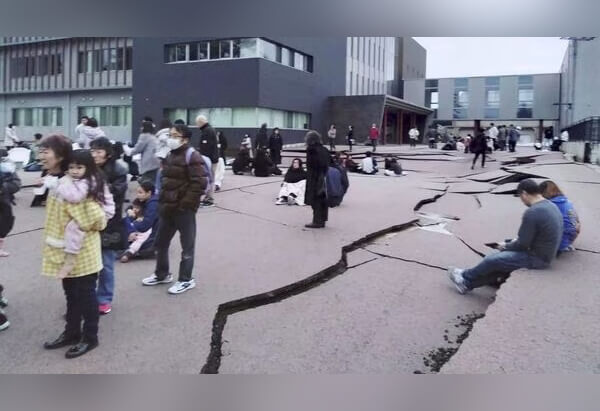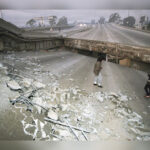Overnight, Thousands Seek Shelter in Japan after Earthquake
Alerts approximately earthquakes and tsunamis
Japanese tsunami (Japan Earthquake) warnings have been issued in Fukushima prefecture following Saturday’s 7.4-significance earthquake. The quake hit at round 11:08 P.M. Local time approximately 50 miles under the ocean floor off Fukushima, in line with United States Geological Survey.
Initially, Japan’s meteorological employer issued tsunami warnings for waves of up to at least one meter for elements of eastern, northeastern and southern Japan. The agency anticipated waves as excessive as 3 meters for a few regions. #Japan #earthquake #tsunami
However, several hours later, the agency revised their prediction, stating that waves would top out at around 20 inches following the earthquake. The change was likely due to the vertical movement of tectonic plates near the epicenter of the quake being less drastic than first estimated. Still, authorities continued urging coastal residents to exercise caution and remain on vigilant alert for possible tidal changes.
Japan Earthquake Coastal Communities Seek Higher Ground Overnight
Even even though the tsunami warnings had been revised downward some hours after the initial earthquake, officers still encouraged that citizens near the coast evacuate and stay alert. Per the warning, as many as 14,000 coastal residents fled their homes for better ground, while others sought refuge at evacuation facilities set up in faculties and network homes.
“As a precautionary measure, we need human beings to move to higher ground and stay on alert,” said disaster management legitimate Toshiaki Mizukami.
Many people sought shelter in facilities converted to temporary evacuation centers. For instance, in the port town of Ofunato about 340 miles northeast of Tokyo, residents took refuge in shelters including the Ofunato Sports Arena and an agriculture complex that usually hosts farmers markets.
Residents rested on gym mats throughout the night as tremors from powerful aftershocks continued to rattle buildings. The earthquake cut power to homes across the region, plunging evacuation sites into darkness. Generators provided backup lighting to the facilities.
“It was an anxious night, with aftershocks, but we took care of each other at the shelter,” said 56-year-old Toru Kuronuma. “So I eventually managed to sleep.”
Aftershock Japan Earthquake Add Further Risk
Even once initial tsunami fears subsided Sunday morning, the earthquake and subsequent seismic activity posed risks of landslides and building collapses in affected areas. Over a dozen aftershock quakes with a magnitude of 5 or higher rattled across Fukushima and Miyagi prefectures during the first 10 hours after the initial 7.4 tremor.
“We need to be fully prepared for aftershocks to hit in coming days, or even months,” said Professor Tatsuhiko Hara, referring to large tremors that can occur days or years after major earthquakes.
One strong inland aftershock just before dawn on Sunday registered as a 6 on the Japanese seismic scale 7 in Fukushima’s Nishigo village. Though the Pacific coast sustained little visible damage from the tsunami thanks to sea walls erected after a devastating 9.0 earthquake that triggered a nuclear disaster in 2011, authorities remained on alert for liquefaction inland. The phenomenon causes loose soil to behave like a liquid, damaging infrastructure.
“There are risks of landslides and older wooden structures being destroyed following aftershocks,” authorities warned of inland areas on Sunday morning. Officials sent emergency crews out to conduct damage assessments and identify potential hazards.
Thousands Begin Returning Home
On Sunday morning, with smaller than anticipated tsunami impacts and evacuation orders lifted, many residents who had taken shelter overnight began returning home or assisting neighbors. Nearly 14,000 spent the night at evacuation sites or elsewhere outside their homes.
In Minamisoma, just 12 miles from the disabled Fukushima nuclear plant, officials visited evacuation facilities to behavior radiation scans before letting the almost 3,000 citizens go back home. Fukushima is the site of the March 2011 catastrophe, while lack of cooling systems sent reactors into meltdowns.
Coastal train operations resumed where limited water damage occurred, allowing residents to travel home more easily. Still, damage from the initial earthquake impacted roadways in some areas. Officials from the Ministry of Land, Infrastructure, Transport and Tourism sent out emergency response teams to conduct repairs to coastal roads.
“It was a sleepless night, but we made it through,” said 65-year-old Mitsunori Inaba, returning by local train to check on his home a few miles inland from the Fukushima coast.
Long Night Evokes Memories of Previous Disasters
For many residents fleeing their homes Saturday night, the experience reopened emotional wounds from Japan’s devastating 2011 trifecta of earthquake, tsunami and nuclear meltdowns that left some 18,000 dead or missing on the northeast coast. The disaster destroyed countless homes and sparked the planet’s worst nuclear accident since Chernobyl.
“This brought back the dreadful memories of that day 11 years ago,” said Takahiro Tanaka, a local shopkeeper sheltering overnight at an evacuation site near Ofunato. ” In my prayers, this giant earthquake would not trigger a tsunami as big as the one we had that time last year.”
In the Fukushima town of Okuma, less than 4 miles from the disabled nuclear power plant that suffered three reactor meltdowns in 2011, local official Masakazu Matsushima expressed a similar sentiment.
“As someone who experienced the Great East Japan Earthquake, I knew that we had to stay calm and secure our own safety, then gather information on evacuation centers,” said Matsushima.
Until Saturday’s temblor, the 2011 Tohoku earthquake had long stood as Japan’s strongest on record. The massive 9.0 magnitude quake not only unleashed tsunami waves reaching over 130 feet high, but permanently moved Japan’s main island several meters east. Just offshore, it also triggered undersea landslides triggering additional localized tsunami waves.
Over 130,000 people from Fukushima alone fled the nuclear disaster in 2011. A full decade after meltdowns began, just 8.5% of evacuated residents returned, hesitant about local radiation levels.
Power Outages Complicate Recovery after Japan Earthquake
The earthquake and ongoing seismic activity added strain in affected areas already impacted by heavy winter snowfall this season. Thousands remained without electricity a full day after the initial 7.4 quake knocked out power lines across eastern and northeastern Japan.
Making matters worse, heavy snow since mid-December has also caused several rounds of power outages prior to this weekend’s temblor. Regional energy companies have struggled to keep pace with insulation repairs and line maintenance between snow storms. Saturday’s earthquake added new power grid issues.
“Ongoing intermittent snowfall in the region further hampers power restoration efforts this weekend,” explained Tokyo Electric Power Company director Satoru Morozumi on Sunday. “Despite the fact that earthquake damage is unlikely, heavy snow can cause lines or their supporting poles to collapse.”
By Sunday evening, electricity had been restored to just under 80,000 households in eastern Japan. However, some 83,000 homes served by seven power companies across Fukushima, Iwate and Miyagi prefectures remained without electricity. Officials stated that some residents under evacuation orders might not see power restoration for over a week while infrastructure undergoes emergency repairs.
Looking Ahead
As of Sunday evening, two elderly women suffered minor injuries from falling, but no tsunami casualties or major damage resulted from the strong earthquake offshore Fukushima and Miyagi. Nonetheless, the event serves as another solemn reminder of Japan’s ongoing vulnerability even 11 years after the horrific 2011 Tohoku triple disaster.
Although the government has funneled trillions of yen into infrastructure upgrades to improve tsunami defenses since 2011, experts acknowledge that no mitigation measures prove completely foolproof. With ocean waters reaching over 650 feet deep fewer than 15 miles from the Fukushima coast, experts cannot rule out risks of a major seismic event triggering 30-foot waves reaching inland areas in the future.
Additionally, increased global storm activity as an apparent symptom of advancing climate change threatens Japan with harsher typhoons and winter storms in coming years – events that could put upgraded tsunami barriers to the test. The island nation has already witnessed record typhoons and snowfall exceeding infrastructure design limits since 2011.
Nonetheless, this week’s earthquake and tsunami warning ultimately amounted to a bullet dodged for now thanks to the region’s bolstered disaster preparedness compared to 2011. Thousands managed to temporarily evacuate basing decisions on early warning alerts, precisely the scenario such systems aim to facilitate. The event also accentuated ongoing recovery struggles for some 2011 disaster survivors facing compounding crises.
“We live with earthquakes and tsunamis here in Tohoku,” reflected Minamisoma mayor Yoshida Kamei. “And once again, we’ll make it through this disaster as a community.”
Stay on top of the latest current affairs news. Click Here.





